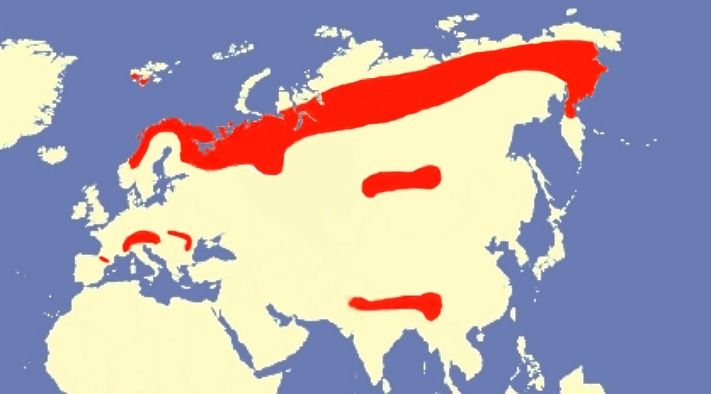
Oliver Gluch's World of Carnivorous Plants or: "What you always wanted to know about butterworts" |
| Impressum |

| Home | Origin | Prey | Species | Plant Purchase | Other Carnivorous Plants | Info about Carnivorous Plants | About me |
Pinguicula alpina Linnaeus (1753)Already
in
1753 Pinguicula alpina was described by the
Swedish naturalist Carl Linnaeus (after his ennoblement
also known as Carl von Linné), the father of modern
plant and animal taxonomy, published in his famous work
"Species Plantarum". In the original species description
only few characters have been cited and the
description is very unspecific (Linnaeus' description
consists of the following details: conical nectary,
short petals, small white flower, short spur). Only
the description of the species in Jost Casper's
monograph of the genus Pinguicula from 1966 gave
for the first time a complete picture of this
widespread, but somehow special butterwort species.
P.
alpina inhabits regions of the Northern
hemisphere. It can be found in subarctic and arctic
areas from Scandinavia over Siberia into Northern
Kamchatka Peninsula, where plants grow from sea level up
to 1100 m above sea level. It inhabits also mountainous
areas in Europe (Alps, Pyrenees, Carpathians) and in
Asia (Himalayas, mountain range of Northern China and
Mongolia). In the Himalayas specimen have been found at
altitudes of 4100 m a.s.l. Recently P. alpina
was also found in the arctic archipelago of Svalbard.
The species is mainly growing on alkaline soils, but can occur also in more acidic soil types, mainly rich in organic material. Major habitats are seepages or fens in the subarctic or arctic regions, alpine turfs mainly along small creeks or waterlogged pastures (often consiting of a small layer of organic compounds above fewly eroded calcareous soil) and wet or damp calcareous rocks or outcrops, where plants often grow in mosses. P.
alpina belongs to the temperate heterophyllous
growth type. During the cold winter months the plants
overwinter as hibernaculum. Often already in early
autumn the hibernaculum is formed. In contrast to the
other temperate species the yellow-white, fleshy, up to
5 cm long roots do not die over winter. In springtime
(depending on the altitude plants are growing) first
summer leaves are formed. The summer rosette forms only
one set of summer leaves. The summer rosette consists of
5-8 elliptic-oblong to lanceolate-oblong leaves,
that are 2,5 to 4,5 cm (sometimes 6 cm) long and
having a pointed to obtuse tip. While at shady locations
the margin of the leaves is only moderately involute, at
more sunny locations the margin is strongly involute
with the margins almost touching. Leaf colour of the
upper surface varies between green and rarely
red-brown), the lower side of the leaves show an intense
brown-red coloration when exposed to direct sunlight.
The upper surface is densely covered with glandular
hairs.
Depending
on
location conditions P. alpina flowers from May
until end of August. Per season 1 to 8 flower scapes can
be formed per plant. The scape is erect, between 5 and
11 cm long , of a green to red-brown colour and glabrous
or covered with only few glandular hairs. For several
characters the flower resembles to those of South
American butterwort species. The corolla is bilabiate.
The petals of the upper lip are of equal size, white,
broadly rotund and 2-4 mm long. The 3 lobes of the
lower lip differ significantly in form and size with the
middle lobe being much larger than the lateral lobes.
The middle lobe is longer than broad, 5-7 mm,
sometimes even 9 mm in length, bearing a yellow palate
in form of 2 humps. The yellow spot can vary
significantly in form and size. The white tube has a
broad entrance, is slightly curved, funnel
shaped and about 1 to 1,5 cm long. The inside of the
tube is lined with several rows (ventrally and lateral)
of white backwards pointing hairs. The outside of the
tube is glabrous and covered with parallel running,
violet or yellow-brown veins. The conical or funnel
shaped spur is short, about 2 to 3 mm long, yellow and
then more yellow-browm towards the tip. The seed capsule
is typically oblong-obovate to oblong-pear shaped and
covered with few glandular hairs. The chromosome
number is 2n = 32.
A
continuous cultivation of P. alpina under
central European lowland conditions is only possible
outside, as in greenhouses, that are heated to stay
frost free over winter, there is a risk that plants
start producing summer leaves already in winter when
temperatures raise significantly during sunny
conditions. Only specimen originated from
low altitude populations of Central Europe (about
400-600 m above sea level) that are adapted to more
warmer growing conditions seem to tolerate conditions of
winter temperatures that do not get lower than 5 °C
during night. It is also important to prevent any root
disturbances e.g. caused by fungus infection or insects
feeding on the roots during dormancy, as then plants
often die. Cultivation of plants in organic soil,
in mosses or in a coarse limestone-peat mix has shown
good results. Also the use of pure vermiculite as
substrate is possible. The roots should be watered from
above from time to time with water rich in oxygen. As P.
alpina does not form daughter buds, the only
natural way of propagation is by seeds.
|
